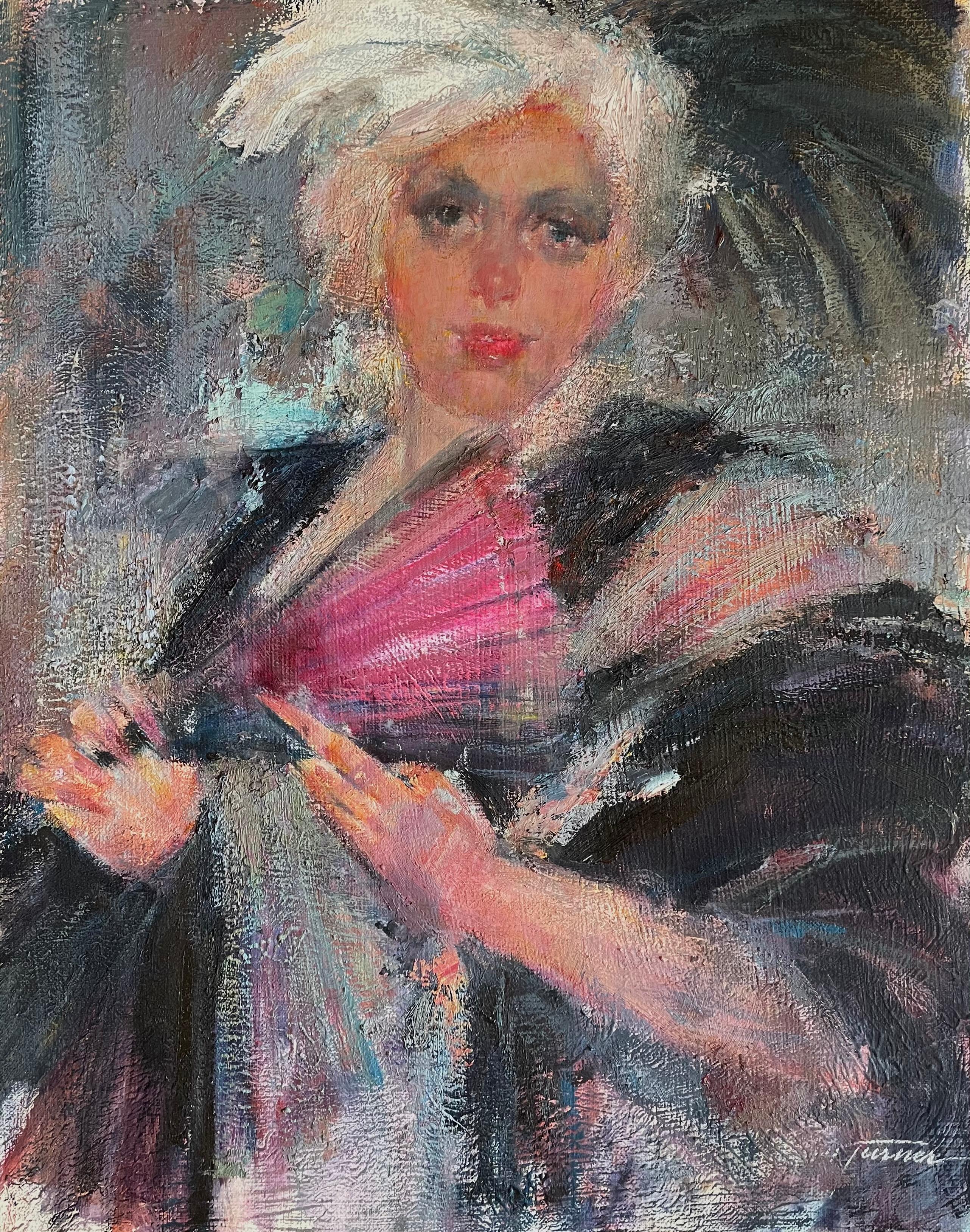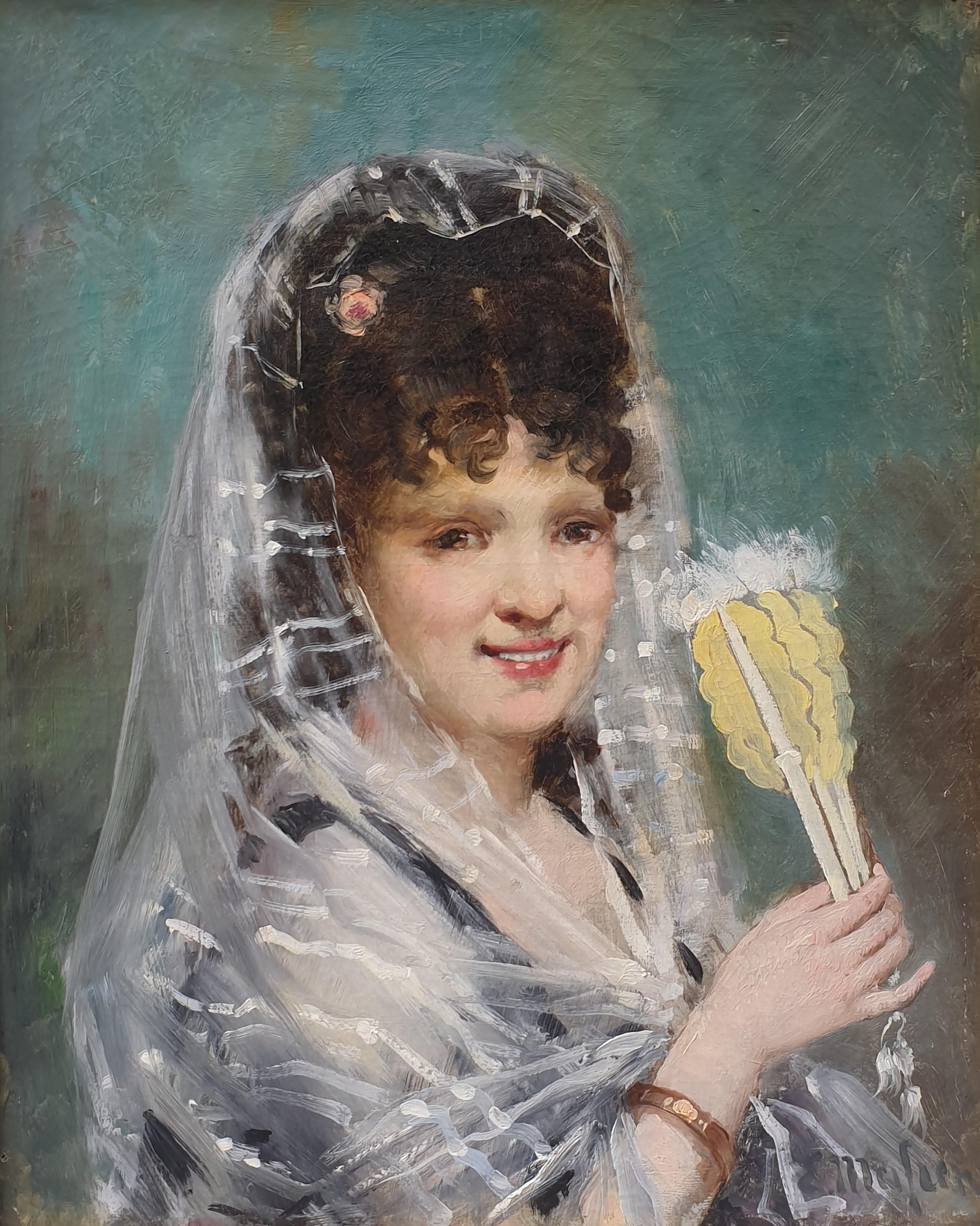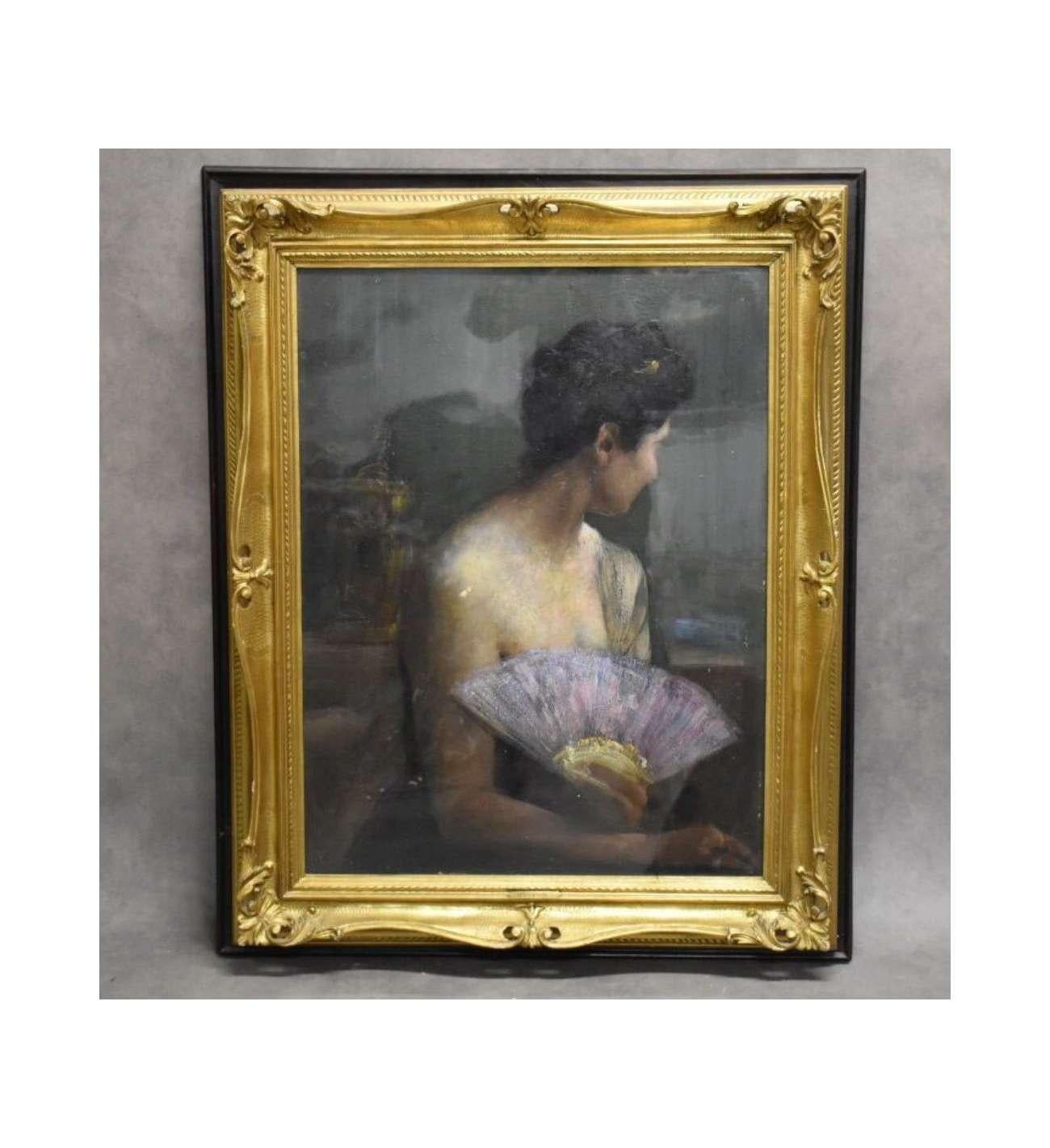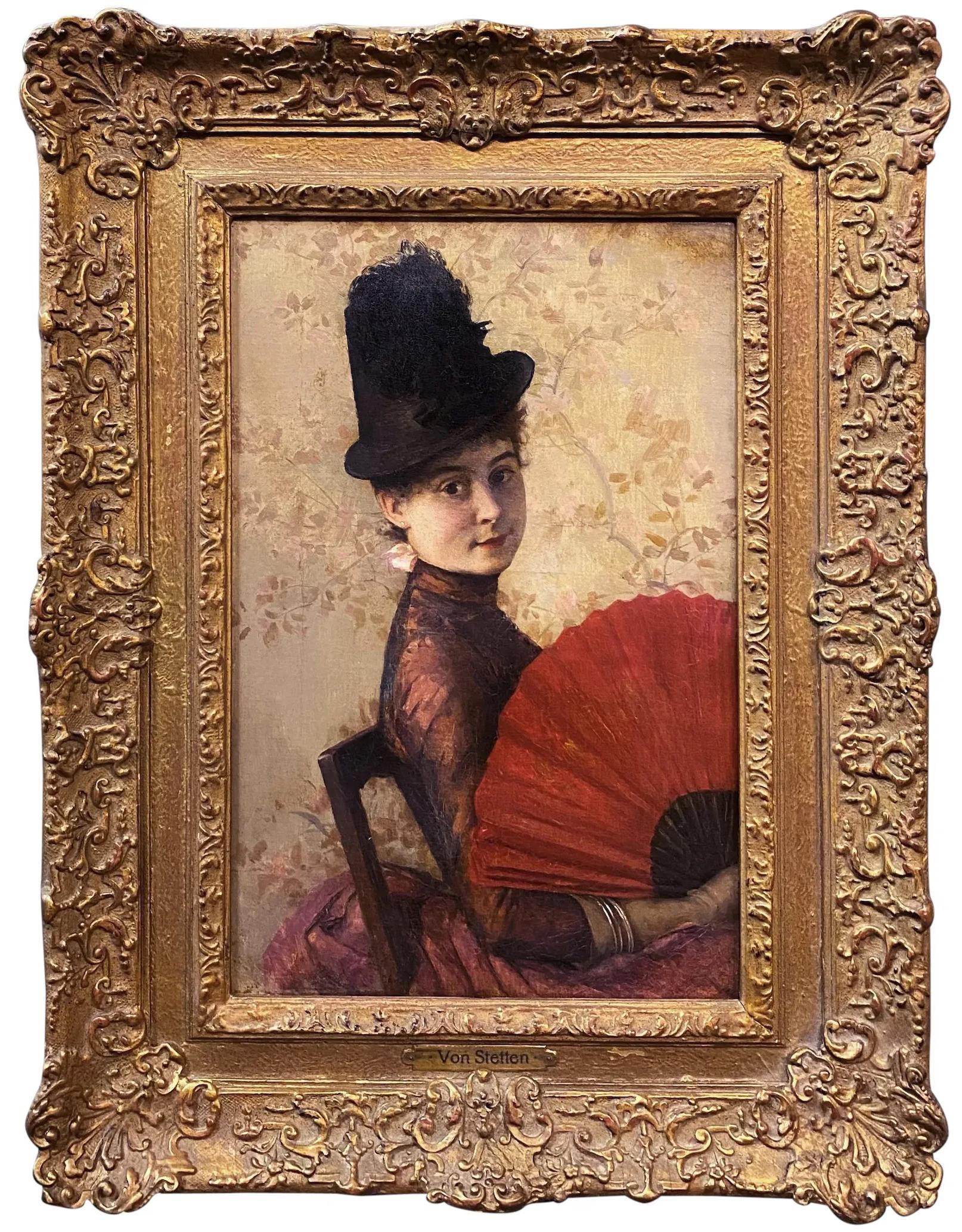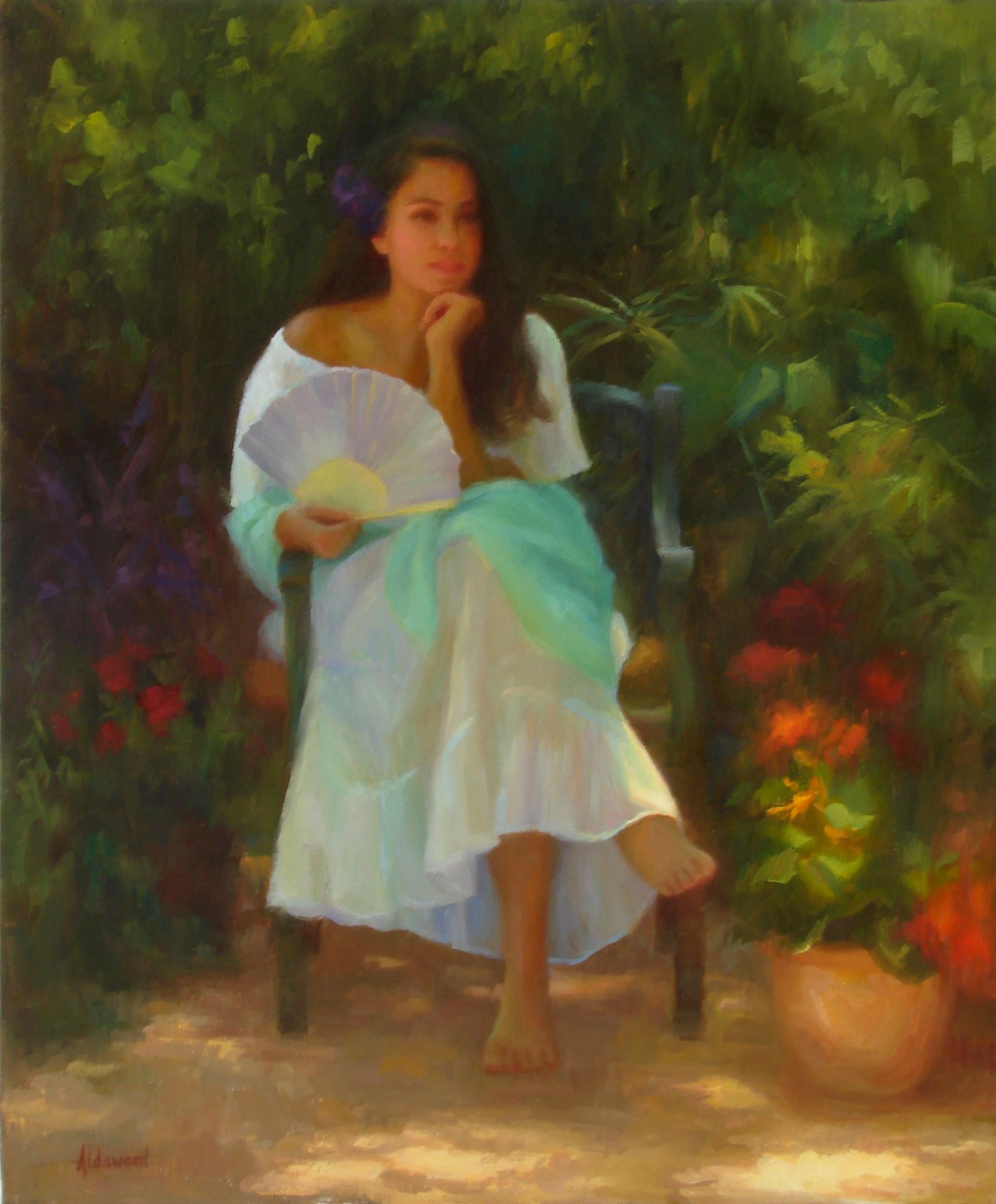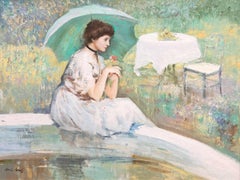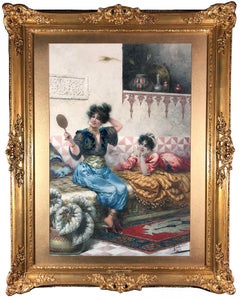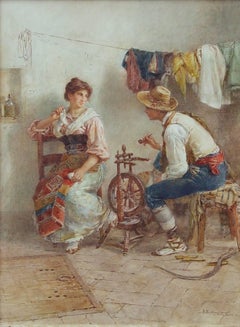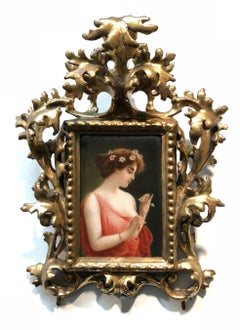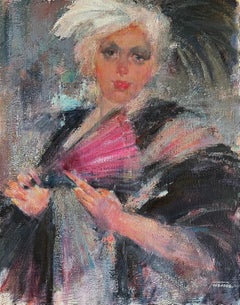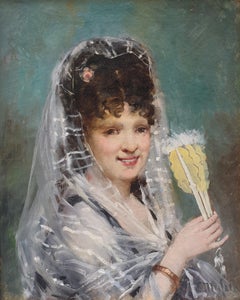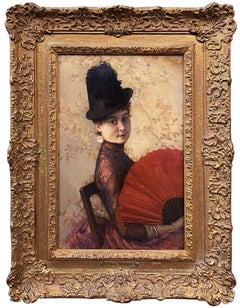Items Similar to Donna con Ventilatore
Video Loading
Want more images or videos?
Request additional images or videos from the seller
1 of 9
Arnaldo LisioDonna con Ventilatore
Price Upon Request
Price Upon Request
Price Upon Request
Price Upon Request
Price Upon Request
Price Upon Request
Price Upon Request
Price Upon Request
Price Upon Request
Price Upon Request
About the Item
Arnaldo de Lisio (Italian, 1869-1949)
Donna con Ventilatore
Oil on Canvas
Signed Lower Right
34 x 24 inches
41 x 31.5 inches
Arnaldo De Lisio (9 December 1869 – 5 March 1949) was an Italian painter.
He was born in Castelbottaccio, Molise. His style was influenced by the works of Domenico Morelli, Ignazio Perrici, and Gioacchino Toma. He traveled to Paris with Pietro Scoppetta and Ragione at the turn of the century, where he was influenced by Impressionism and completed colorful paintings of urban vistas. He returned to Italy and painted also portraitist and genre scenes. He painted frescoes for the Banca d'Italia and Istituto Pilla of Campobasso, for the Santuario Maria Santissima di Campiglione in the town of Caivano in 1938, and the ceiling of the Teatro Savoia in Campobasso.
- Creator:Arnaldo Lisio (1869 - 1949, Italian)
- Dimensions:Height: 34 in (86.36 cm)Width: 24 in (60.96 cm)
- Medium:
- Movement & Style:
- Period:
- Condition:
- Gallery Location:Missouri, MO
- Reference Number:1stDibs: LU747315922952
About the Seller
5.0
Vetted Professional Seller
Every seller passes strict standards for authenticity and reliability
Established in 1970
1stDibs seller since 2017
156 sales on 1stDibs
Typical response time: Several days
- ShippingRetrieving quote...Shipping from: Missouri, MO
- Return Policy
Authenticity Guarantee
In the unlikely event there’s an issue with an item’s authenticity, contact us within 1 year for a full refund. DetailsMoney-Back Guarantee
If your item is not as described, is damaged in transit, or does not arrive, contact us within 7 days for a full refund. Details24-Hour Cancellation
You have a 24-hour grace period in which to reconsider your purchase, with no questions asked.Vetted Professional Sellers
Our world-class sellers must adhere to strict standards for service and quality, maintaining the integrity of our listings.Price-Match Guarantee
If you find that a seller listed the same item for a lower price elsewhere, we’ll match it.Trusted Global Delivery
Our best-in-class carrier network provides specialized shipping options worldwide, including custom delivery.More From This Seller
View AllMorning Reflection
By Hans Amis
Located in Missouri, MO
Hans Amis (AKA An He)
"Morning Reflection"
Oil on Canvas
30 x 40 inches, site
38 x 48 inches framed
An He was born in Guangzhou, China into an artistic family. He was drawn to the...
Category
1990s Impressionist Figurative Paintings
Materials
Canvas, Oil
Price Upon Request
An Opulent Evening
By Guiseppe Aureli
Located in Missouri, MO
Guiseppe Aureli (1858-1929)
"An Opulent Evening" c. 1880s
Watercolor on Paper
Signed Lower Right
Site Size: approx. 30 x 20 inches
Framed Size: approx. 37 x 29 inches
Giuseppe Aureli (December 5, 1858 in Rome – 1929) was an Italian painter and watercolorist. His work is noted for its historical subject matter, portraits of Italian noble families as well as genre paintings and local scenes, especially work with Oriental themes.
He received his early art education at the Academia de San Luca where he was the pupil of Pietro Gabarini and Cesare Maccari.[1] He exhibited in various exhibitions; including: The International Exhibition of 1888 in Munich and the World Fair of 1893 in Chicago, but his Oriental works were rarely included in these early exhibitions. Having his workshop at 48 Via Margutta in Rome, Aureli was in a position to exchange ideas with the most prolific Orientalist artists at that the time. He used the same staircase that led to a rabbit-warren of studios including those of Filippo Bartolini, Enrico Tarenghi...
Category
Late 19th Century Victorian Figurative Drawings and Watercolors
Materials
Watercolor, Laid Paper
Price Upon Request
The Flirtation
By Allesandro Battaglia
Located in Missouri, MO
Allesandro Battaglia (1870-1940, Italian)
"The Flirtation" 1906
Watercolor on Paper
Signed "A. Battaglia, Roma 1906"
Site Size: 30 x 20 inches
Framed Size: approx 41 x 33 inches
Son of Clelia Bompiani and Ercole Battaglia, he was trained by his grandfather Roberto Bompiani...
Category
Early 1900s Realist Figurative Drawings and Watercolors
Materials
Watercolor, Archival Paper
Price Upon Request
Marguerite
By Königliche Porzellan-Manufaktur (KPM)
Located in Missouri, MO
Marguerite
Hand Painted Porcelain
w/crown stamp #107
Signed "Wagner"
Original Gilded Florentine Frame
approx 6 x 4 inches /approx 14 x 8 inches framed
Since 250 years, the royal sc...
Category
Late 19th Century Victorian Figurative Paintings
Materials
Porcelain, Oil
Price Upon Request
Madonna
Located in Missouri, MO
Madonna by Louis Carl Hvasta (1913-1993)
Unframed: 37" x 24"
Framed: 47.75" x 34"
Signed and Dated Lower Left
Frame was Hand Made by the artist himself.
A local Californian Artist, ...
Category
20th Century American Impressionist Portrait Paintings
Materials
Oil, Panel
Price Upon Request
Dessert in the Garden
Located in Missouri, MO
Provenance:
This is an early painting by Huldah Mae Cherry (also known as Huldah Cherry Jeffe), done in her "Impressionist years" and painted after a painting by another American I...
Category
1920s American Impressionist Figurative Paintings
Materials
Canvas, Oil
You May Also Like
LADY WITH PICK FAN
Located in Los Angeles, CA
Biography from the niece of the artist from during his lifetime. Paintings acquired from the artist.s estate.
Max Turner
1925 - 2019
Max Lamar Turner Painter, Sculptor, Teacher and Author.
Max Turner was born in Omaha, Nebraska on July 28, 1925. His father was Lance Howard Turner and his mother Mary Irene Turner. In 1927, his family moved to Bingham Canyon, Utah where Max's father extracted copper from a creek that he had diverted to pass through his garage. The town was located in a narrow canyon on the eastern face of the Oquirrh Mountains. In 1938, when Max was 13, his family moved to Midvale, Utah. After completing high school, Max went to work laying rail until he was inducted into the U.S. Navy to serve during W.W. II.
There he took an aptitude test and was initially assigned to the medical corp., later transferring to the dental unit. Max was stationed at Port Hueneme, Ventura County, California through the end of the war. When he was discharged in 1946, he remained in Southern California, living in the Los Angeles area. He met a man named Larry Torres and they formed a partnership to do silk screen work primarily for the Colby Poster Printing Company. This lasted about 10 years until the Colby building caught fire and burned down. In 1958, Max began working for Slade Novelty company that made doll parts using a product called plastisol. A year later, Max began producing plastic parts through his own business. One day, a couple of kids brought in a shrunken skull they had made and asked Max if he could reproduce it. Max said he could and he looked around for a business to work with for this task. He ultimately decided he could create his own machine shop to make molds. As a result, Max purchased a lathe, drill press, grinder and other tools to create his own machine shop and went into business making molds. He built a clientele and in 1973, he moved his machine shop to Glendale, California.
Painter, Sculptor, Teacher and Author:
Max recalls the day when his interest in art took a new direction. He happened to be in a paint store to purchase some supplies when he saw a card posted on a wall that read, "Come paint with Connie Marlo". Max had been interested in art since his youth and he was frequently impressed with paintings displayed by local artists at various community events.
Consequently, he decided to go to Connie's Saturday morning art class at a studio on North La Brea Avenue (between Sunset and Hollywood) in Los Angeles. But, as fate would have it, he immediately took a detour from this class when he found a piece of paper on the floor of the studio referencing another art class dealing with compositions, patterns, rhythms and color harmony. The instructor's name was Hal Reed, a former art student of the Russian/American Master, Nicolai Fechin. Hal owned the building (previously the Will Foster Studio) and had founded the Art League of Los Angeles. When Max found Hal, he asked Hal if he could join his class. Hal said "No, the class was full" but he said Max could monitor the class in the back of the classroom. Max took him up on the offer and began observing the weekly class.
During the class, Hal told his students that they should practice what they were learning by going to "live model" classes. Max began attending these classes where he learned how to draw figures. After a few months, Hal and Max became good friends. Hal was so impressed with Max's work that he offered Max the opportunity to teach at another location that Hal was opening in the San Fernando Valley. Max accepted the offer and began teaching his own art class. For Max, it was a quick jump from learning to teaching. Max then found that several of his students had to commute to his art class from the west end of the "Valley". To better serve this group of students, Max decided to relocate to another studio in Calabasas.
Max continued teaching, and at this time he was producing very impressive portraits, both oil paintings and charcoal drawings from live models (Max never worked from photos). Max demonstrated real talent, and the style of his drawings and paintings were being compared to those of Nicolai Fechin. And, like Fechin, Max also had an interest in sculpting. One day, Max decided to design and cast a bronze owl sculpture to put in his Calabasas Fine Art Gallery. Later, someone approached Max when he was at the foundry and asked him about his success selling the owl sculpture. The individual who asked this question was convinced that there was a broader market for these sculptures and he ordered a dozen of the owl sculptures from Max. This encouraged Max to do more castings. Some of the new castings were antique sculptures he found and reproduced. As this new business grew, he decided to establish his own foundry, employing up to 15 workers. The business continued for many years, up until the late 1990's when Max got tired of the foundry business and sold it.
Max, who was now in his 70's, decided to move on to his next venture as an artist, dedicating himself to doing the actual sculpting of original art. He loved the creativity of sculpting and he had his sculptures cast at local foundries, ironically the same ones that used to be his competition. Max was now fully engaged in his new artistic direction and, over time, he produced a large body of work. He created very impressive sculptures, including about 100 full-size sculptures. He sold some of these to high-end clientele, the Foundry at SLS Las Vegas, and to Hollywood studios.
Even though Max now seemed to be totally in his element, he somehow also found time to continue to teach painting classes at the California Art Institute in Westlake Village in Los Angeles. At the institute, he specialized in figure work. Max continued to draw, paint and teach, but he says he stopped sculpting when he turned 90.
Max produced four books showcasing his drawings and paintings. The first is "Faces, The Drawings of Max Turner", copyright 2000, that showcases nearly 100 of his portrait drawings. Within the "Acknowledgements" section, he lists Hal Reed and Joseph Nordmann, two former students of Nicolai Fechin.
In 2006, Max produced his second book titled "Figures and Faces", reflecting not only portraits but also figure drawings and paintings. It is a wonderful book of Max's work, but it is currently difficult to find. The third book is titled "Faces 2, The Paintings and Drawings of Max Turner", copyright 2009, which includes 75 portrait paintings and drawings. In the "Preface" of this book, Max describes growing up in a small and isolated mining town during the Great Depression. He states that as a kid, he had little exposure of any culture or view of what the rest of the world was like. His neighbor was the trash collector and Max would sometimes go through his truck looking for anything of value. Among other things, he found magazines like Cosmopolitan, Good Housekeeping and Red Book, with covers that frequently showed drawings or paintings of faces. Max states that these images were the very first source of inspiration for him. He says that he began looking more carefully at people's faces and if they had character, he would draw them. By drawing them, Max says that he was making them part of his world, his world of "Faces".
In 2018, Max published his newest book showcasing his drawings and paintings. It is titled "Max Turner's Figure Sketches". This softbound book includes 76 pages and over 120 drawings and paintings. In the Introduction, Max explains "I have found that when approaching the figure, one should begin with the gesture. After having captured the essence or feeling of the pose, one can then proceed to build on it." The figure sketches in this wonderful book reflect a Master's work that consistently captures the "gesture"-showing the emotion, movement and expression.
Two more books are on the horizon for Max, both dealing with his passion for sculpting. His first, "The Sculpture of Max Turner" is a compilation of his commercial and noncommercial pieces throughout his career. The second, "Terra Cotta Sculpture by Max Turner" is a complete collection of figures done at the California Art Institute. These much anticipated books should be out later in 2018.
Max now considers himself primarily a sculptor. But others in the art world are more than impressed with his drawings and paintings as well. His portraits are often described as having a Fechin-esque appearance, referring to the style of Nicolai Fechin. When Max observed those first art classes given by Hal Reed, it should be noted that Hal had previously been a student of the Russian/American Master Nicolai Fechin in the early to mid-1950's. In fact, Hal was a student in the last art class that Fechin taught before he unexpectedly died in 1955. Hal was so strongly influenced by Fechin that he later produced two 30-minute art instruction videos as part his Art Video Productions wherein he specifically described Fechin techniques that he learned in Fechin's class. The Fechin style and techniques were in play when Max later met Hal. Over the years, many of Max's art students, art collectors, gallery owners, as well as the Director of the Monterey Museum of Art have commented on the Fechin-esque qualities of Max's wonderful charcoal drawings and paintings. So, while Max may consider himself primarily a sculptor, his drawings and paintings are also impressive and very much sought after.
When Nicolai Fechin died in 1955, three of the nine students in his last art class became life-long friends. Max subsequently became friends with not only Hal Reed, but also with prior Fechin students Joseph Nordmann and Albert Londraville...
Category
1990s Modern Figurative Paintings
Materials
Canvas, Oil
$450 Sale Price
64% Off
MEIFREN Painting portrait Spanish woman with a fan 19th century
Located in PARIS, FR
Eliseo MEIFREN
Barcelona, 1859 – Barcelona, 1940
Oil on canvas
41 x 33 cm (57 x 49.5 cm with frame)
Signed lower right “E. Meifren”
Beautiful 19th century frame in gilded wood
...
Category
Late 19th Century Impressionist Portrait Paintings
Materials
Oil
$2,719 Sale Price
38% Off
Anita With A Fan By Luigi Brignoli
Located in Gent, VOV
"Anita With A Fan By Luigi Brignoli"
Anita with Fan.
Certificate of authenticity. (glued to the back of the painting)
Framed under glass in a period frame.
Luigi Brignoli attende...
Category
20th Century Realist Portrait Paintings
Materials
Oil
Portrait of a Woman with a Fan
Located in Milford, NH
A finely detailed portrait of a beautiful young woman with a fan by Franco-German artist Carl Ernst Von Stetten (1857-1942). Stetten was a Franco-German portrait and genre painter who worked in France. He came from the wealthy Stetten banking family. He began his studies on October 16, 1876 in the class of antiquities at the Royal Academy of Arts in Munich. He then left for Paris in the 1880s to study under Jean-Léon Gérôme. He attended the Académie Julian with Gustave Boulanger, Gustave Courtois...
Category
1880s Portrait Paintings
Materials
Canvas, Oil
Woman with paipai fan oil on canvas painting portrait
By Joan Palet
Located in Sitges, Barcelona
Joan Palet (1911 - 1996) - Female figure - Oil on canvas
Oil measures 81x65 cm.
Frameless.
Joan Palet was born in Barcelona on March 28, 1911 in a family of sculptors and wood carve...
Category
1970s Impressionist Portrait Paintings
Materials
Canvas, Oil
Alana with Fan, Oil Painting
By Sherri Aldawood
Located in San Francisco, CA
Artist Comments
Artist Sherri Aldawood posed her model, Alana, in her backyard garden on a warm summer day. She positioned in her the shade of dense green plants and glowing ...
Category
21st Century and Contemporary Abstract Impressionist More Art
Materials
Oil
More Ways To Browse
Dutch Realism
Eugene Fromentin
Flamenco Dancer Paintings
Francesco Albani
Girl In Pink Dress
Hockey Painting
Indian Dance Painting
Jacques Doucet
London Transport Museum Vintage Posters
Melissa Hefferlin
Michelangelo Pieta
Mike Carson
Musketeer Oil
Natalia Makarova
Natalya Nesterova
Oil Painting Eiffel Tower
Oil Painting Girl Reading
Oil Painting Las Vegas
